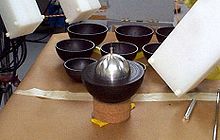Neptunyo
 | |||||||||||||||||||||||||||||||||||||
| Neptunium | |||||||||||||||||||||||||||||||||||||
|---|---|---|---|---|---|---|---|---|---|---|---|---|---|---|---|---|---|---|---|---|---|---|---|---|---|---|---|---|---|---|---|---|---|---|---|---|---|
| Bigkas | /nɛpˈtjuːniəm/ | ||||||||||||||||||||||||||||||||||||
| Appearance | silvery metallic | ||||||||||||||||||||||||||||||||||||
| Bilang na pangmasa | [237] | ||||||||||||||||||||||||||||||||||||
| Neptunium sa talahanayang peryodiko | |||||||||||||||||||||||||||||||||||||
| |||||||||||||||||||||||||||||||||||||
| Atomikong bilang (Z) | 93 | ||||||||||||||||||||||||||||||||||||
| Group | n/a | ||||||||||||||||||||||||||||||||||||
| Period | 7 | ||||||||||||||||||||||||||||||||||||
| Block | f-block | ||||||||||||||||||||||||||||||||||||
| Electron configuration | [Rn] 5f4 6d1 7s2 | ||||||||||||||||||||||||||||||||||||
| Electrons per shell | 2, 8, 18, 32, 22, 9, 2 | ||||||||||||||||||||||||||||||||||||
| Physical properties | |||||||||||||||||||||||||||||||||||||
| Phase at STP | solido | ||||||||||||||||||||||||||||||||||||
| Melting point | 912±3 K (639±3 °C, 1182±5 °F) | ||||||||||||||||||||||||||||||||||||
| Boiling point | 4447 K (4174 °C, 7545 °F) (extrapolated) | ||||||||||||||||||||||||||||||||||||
| Density (at 20° C) | 20.48 g/cm3 (237Np)[1] | ||||||||||||||||||||||||||||||||||||
| Heat of fusion | 5.19 kJ/mol | ||||||||||||||||||||||||||||||||||||
| Heat of vaporization | 336 kJ/mol | ||||||||||||||||||||||||||||||||||||
| Molar heat capacity | 29.46 J/(mol·K) | ||||||||||||||||||||||||||||||||||||
Vapor pressure
| |||||||||||||||||||||||||||||||||||||
| Atomic properties | |||||||||||||||||||||||||||||||||||||
| Oxidation states | +2, +3, +4,[2] +5, +6, +7 (isang anpoterong oksido) | ||||||||||||||||||||||||||||||||||||
| Electronegativity | Pauling scale: 1.36 | ||||||||||||||||||||||||||||||||||||
| Ionization energies |
| ||||||||||||||||||||||||||||||||||||
| Atomic radius | empirical: 155 pm | ||||||||||||||||||||||||||||||||||||
| Covalent radius | 190±1 pm | ||||||||||||||||||||||||||||||||||||
| Other properties | |||||||||||||||||||||||||||||||||||||
| Natural occurrence | mula sa pagkabulok | ||||||||||||||||||||||||||||||||||||
| Crystal structure | orthorhombic (oP8) | ||||||||||||||||||||||||||||||||||||
| Lattice constants | a = 472.3 pm b = 488.7 pm c = 666.3 pm (at 20 °C)[1] | ||||||||||||||||||||||||||||||||||||
| Thermal conductivity | 6.3 W/(m⋅K) | ||||||||||||||||||||||||||||||||||||
| Electrical resistivity | 1.220 µΩ⋅m (at 22 °C) | ||||||||||||||||||||||||||||||||||||
| Magnetic ordering | paramagnetic[3] | ||||||||||||||||||||||||||||||||||||
| CAS Number | 7439-99-8 | ||||||||||||||||||||||||||||||||||||
| History | |||||||||||||||||||||||||||||||||||||
| Naming | after planet Neptune, itself named after Roman god of the sea Neptune | ||||||||||||||||||||||||||||||||||||
| Discovery | Edwin McMillan and Philip H. Abelson (1940) | ||||||||||||||||||||||||||||||||||||
| Isotopes of neptunium | |||||||||||||||||||||||||||||||||||||
| |||||||||||||||||||||||||||||||||||||
Ang Neptunyo o Neptunium ay isang elementong kimika may simbolong Np at bilang na atomikong 93. Isang radioactive na aktinidong metal, ang neptunyo ay ang unang elementong transuraniko. Ang posisyon nito sa talaang peryodiko ay pagkatapos lamang ng uranyo, na ipinangalanan pagkatapos ng planetang Urano, na humantong sa inito sa Neptuno, ang sumunod na planeta na lampas sa Urano. Ang isang neptunium atom ay may 93 proton at 93 elektron, kung saan pito ang ang valence elektron. Ang metal na neptunyo ay pilak at masisira kapag nakalantad sa hangin. Ang elemento ay nangyayari sa tatlong mga form na allotropic at normal itong nagpapakita ng limang mga estado ng oksihenasyon, mula sa +3 hanggang +7. Ito ay radioactive, lason, pyrophoric, at may kakayahang makaipon sa mga buto, na kung saan ay mapanganib ang paghawak ng neptunyo.
Bagaman maraming maling sinasabing pagkatuklas nito ang nagawa sa mga nakaraang taon, ang elemento ay unang nagawa nina Edwin McMillan at Philip H. Abelson sa Berkeley Radiation Laboratory noong 1940.[5] Simula noon, ang karamihan sa neptunyo ay, at patuloy pa ring, ginawa sa pamamagitan ng neutron irradiation ng uranium sa mga nuclear reactor. Ang karamihan ay nabuo bilang isang produkto sa mga pangkaraniwang reaktor ng enerhiyang nukleyar. Habang ang neptunyo mismo ay walang komersiyal na gamit sa kasalukuyan, ginagamit ito bilang pauna para sa pagbuo ng plutonyo-238, ginagamit sa radioisotope thermal generators upang magbigay ng elektrisidad para sa spacecraft. Ang Neptunium ay ginamit din sa mga detektor ng mga neutron na may mataas na enerhiya.
Ang pinakamahabang isotopo ng neptunyo, neptunyo-237, ay isang produkto ng mga nukleyar na reaktor at paggawa ng plutonyo. Ito, at ang isotope neptunyo-239, ay matatagpuan din sa mga halaga ng bakas sa mga mineral ng uranyo dahil sa mga reaksiyon ng neutron capture at pagkabulok beta.[6]
Mga sanggunian
[baguhin | baguhin ang wikitext]- ↑ 1.0 1.1 Arblaster, John W. (2018). Selected Values of the Crystallographic Properties of Elements. Materials Park, Ohio: ASM International. ISBN 978-1-62708-155-9.
{{cite book}}: CS1 maint: date auto-translated (link) - ↑ Np(II), (III) and (IV) have been observed, see Dutkiewicz, Michał S.; Apostolidis, Christos; Walter, Olaf; Arnold, Polly L (2017). "Reduction chemistry of neptunium cyclopentadienide complexes: from structure to understanding". Chem. Sci. (sa wikang Ingles). 8 (4): 2553–2561. doi:10.1039/C7SC00034K. PMC 5431675. PMID 28553487.
{{cite journal}}: CS1 maint: date auto-translated (link) - ↑ Magnetic susceptibility of the elements and inorganic compounds, in Handbook of Chemistry and Physics 81st edition, CRC press.
- ↑ Kondev, F. G.; Wang, M.; Huang, W. J.; Naimi, S.; Audi, G. (2021). "The NUBASE2020 evaluation of nuclear properties" (PDF). Chinese Physics C. 45 (3): 030001. doi:10.1088/1674-1137/abddae.
{{cite journal}}: CS1 maint: date auto-translated (link) - ↑ McMillan, Edwin; Abelson, Philip Hauge (1940-06-15). "Radioactive Element 93". Physical Review. 57 (12): 1185–1186. Bibcode:1940PhRv...57.1185M. doi:10.1103/PhysRev.57.1185.2.
{{cite journal}}: CS1 maint: date auto-translated (link) - ↑ C. R. Hammond (2004). The Elements, in Handbook of Chemistry and Physics (ika-81st (na) edisyon). CRC press. ISBN 978-0-8493-0485-9.
{{cite book}}: CS1 maint: date auto-translated (link)


